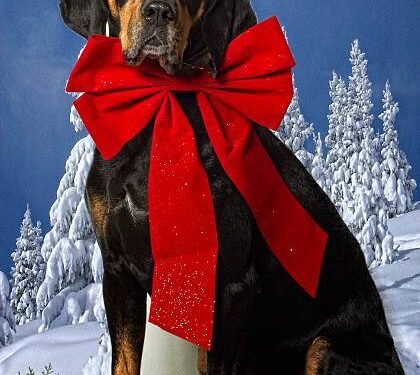Table of Contents
Introduction
The Black and Tan Coonhound, often simply referred to as the “Coonhound,” is a remarkable and distinctive breed known for its exceptional hunting abilities and affectionate nature. If you’re considering bringing a Black and Tan Coonhound into your life, you’re in for a loyal and energetic companion that’s as unique as they come.
What sets the Black and Tan Coonhound apart is its extraordinary scenting and tracking capabilities. These dogs have a nose for adventure and are well-suited for hunting raccoons and other game. However, their versatility and loving temperament also make them wonderful family pets.
Selecting the right dog breed is a significant decision that can influence your lifestyle and daily routines. Understanding a breed’s characteristics and needs is paramount. Let’s delve into the specific characteristics of the Black and Tan Coonhound and explore what makes them a distinctive and delightful breed. Below is a table detailing essential information about the Black and Tan Coonhound:
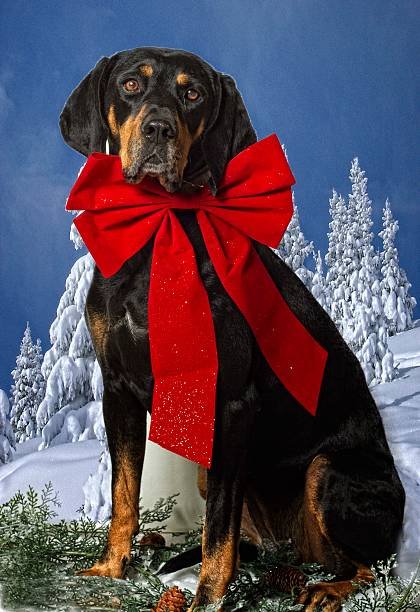
| Field | Information |
|---|---|
| Height | 25 to 27 inches |
| Weight | 65 to 75 pounds |
| Life Span | 10 to 12 Years |
| Good with | Families, children |
| Temperament | Friendly, loyal, alert |
| Intelligence | Moderate to high |
| Shedding Amount | Moderate |
| Grooming | Low |
| Exercise Needs | High |
| Energy Level | High |
| Barking Level | Moderate to high |
| Drool Amount | Low |
| Coat Length/Texture | Short, dense, sleek |
| Colors | Black and tan |
| Patterns | Black and tan |
The Black and Tan Coonhound’s unique characteristics, including its hunting prowess, loyalty, and energy, make it a suitable choice for those who lead an active lifestyle or are looking for a devoted family pet.
In the following sections, we will explore the history, physical attributes, temperament, care requirements, and much more to provide you with an in-depth understanding of the captivating Black and Tan Coonhound.
Breed History and Origin
Exploring Their Roots
The Black and Tan Coonhound’s history is a journey that takes us back to the early days of hunting in the United States. The breed’s development is closely tied to the need for a versatile and reliable hunting companion capable of tracking and treeing raccoons. As we delve into their historical roots, you’ll gain insight into the fascinating origin of this exceptional breed.
1. Historical Development
The Black and Tan Coonhound’s history dates back to colonial America. The breed was meticulously developed in the southern United States, particularly in the Appalachian regions. Early American settlers sought dogs with exceptional hunting skills, and the Black and Tan Coonhound quickly emerged as the preferred choice for raccoon hunting.
2. Ancestors of the Coonhound
While the precise lineage of the Black and Tan Coonhound is not always well-documented, it’s believed that several breeds played a significant role in their development. Bloodhounds, Foxhounds, and Virginia Foxhounds were among the breeds that contributed to their genetic makeup. The Bloodhound influence is particularly evident in the Coonhound’s excellent scenting abilities.
3. Hunting Tradition
The Black and Tan Coonhound was primarily bred for raccoon hunting. Their name is a direct reflection of their coat color – a sleek black body with distinctive tan markings. This coat pattern not only gives them a striking appearance but also serves a practical purpose. Their dark coat helps them blend into the night while chasing raccoons, and the tan markings are visible in daylight.
Notable Traits
The Black and Tan Coonhound boasts several distinctive traits that set them apart in history:
1. Exceptional Tracking Skills: Their scenting abilities are unmatched, making them exceptional at tracking raccoons and other game. Their persistent pursuit and distinct baying vocalization were valued by hunters.
2. Versatile Hunter: While their primary role was coon hunting, these dogs were also used for hunting other game such as opossums, bobcats, and mountain lions. Their versatility as hunters made them a valuable asset to outdoorsmen.
3. Resilience: The breed’s history in the rugged terrain of the Appalachian regions required them to be hardy and resilient. They could withstand harsh conditions and long hunting treks.
Relevance of Origin
The origin of the Black and Tan Coonhound plays a significant role in defining their characteristics today:
1. Scenting Ability: The breed’s exceptional scenting skills, a legacy of their Bloodhound ancestry, remain a defining trait. Their remarkable ability to pick up and follow scents is an asset in various situations, even as family pets.
2. Coat Pattern: The distinctive black and tan coat pattern continues to be a cherished feature of the breed. While no longer a practical consideration for hunting, it adds to their visual appeal and uniqueness.
3. Versatility: The breed’s versatility as a hunting companion remains ingrained in their nature. While many Black and Tan Coonhounds are now cherished as family pets, they still retain their keen hunting instincts.
In the following sections, we will delve into the physical characteristics, temperament, care requirements, and health considerations that are essential for understanding and caring for the Black and Tan Coonhound, a breed deeply rooted in American history.
Understanding the Black and Tan Coonhound Breed’s Traits
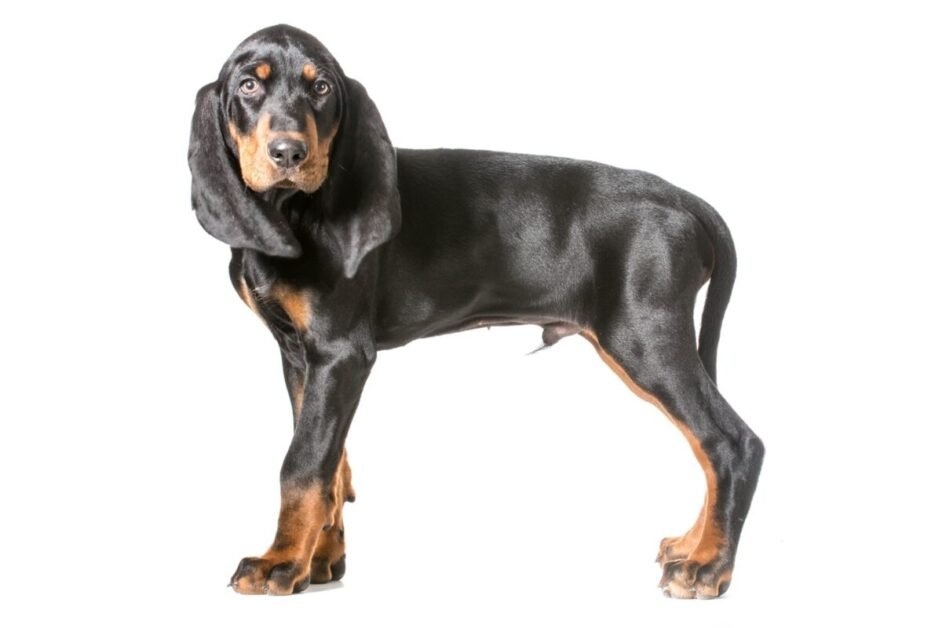
Physical Characteristics
The Black and Tan Coonhound is a striking breed with distinct physical attributes that contribute to its uniqueness. Understanding these characteristics will help you appreciate their appearance and suitability for various lifestyles.
- Size: While the precise height and weight of Black and Tan Coonhounds may vary somewhat, they typically fall within the medium to large dog category. Males usually stand around 25 to 27 inches tall at the shoulder and weigh between 65 to 75 pounds, while females are slightly smaller.
- Coat Type: Their coat is short, dense, and sleek. The black and tan coloration is a hallmark of the breed. The coat is waterproof and resistant to thorns and rough terrain, which was essential for their hunting roles.
- Color: The name of the breed gives away its primary coat colors – black with distinctive tan markings. The combination creates an eye-catching contrast that’s easily recognizable.
- Distinguishing Features: Apart from their coat, Black and Tan Coonhounds have an expressive face with long ears that hang down. Their eyes are large and dark, reflecting their friendly and alert nature. Their tail is medium in length and tapers at the end.
Temperament Overview
Understanding the temperament of the Black and Tan Coonhound is crucial for anyone considering this breed. They have a unique personality that combines a strong hunting instinct with a loving and loyal disposition.
- Suitability as Family Pets: Black and Tan Coonhounds can make excellent family pets. They are known for their affectionate nature and loyalty to their human companions. Their patience with children often surprises and delights families.
- Compatibility with Other Pets: While they have a strong prey drive due to their hunting background, many Black and Tan Coonhounds can coexist with other pets, including dogs, cats, and even small animals. Early socialization is key to their success with other animals.
- Environment Needs: These dogs thrive in homes with access to a secure, fenced yard. Their high energy level requires regular exercise. Black and Tan Coonhounds are adaptable to various climates, but they do not tolerate extreme heat well. Special care should be taken in hot weather.
Common Behavioral Traits
Black and Tan Coonhounds exhibit a range of behavioral traits, some of which can be positively harnessed, while others may require careful management:
- Baying: The Coonhound’s baying vocalization is legendary. They use this unique and melodious sound to alert their human companions to scents and to track game. While this is part of their charm, it may not be appreciated by close neighbors.
- Loyalty: Coonhounds are profoundly loyal dogs. They form strong bonds with their families and are often protective. This loyalty makes them trustworthy companions.
- Independence: Due to their hunting background, Black and Tan Coonhounds can display a level of independence. They have been bred to track and tree game without constant human direction.
- Energy: These dogs have a high energy level and require regular exercise. Daily walks, playtime, and opportunities to explore their environment are essential to their well-being.
- Scent Drive: Their extraordinary scenting abilities can lead to some interesting behaviors. They might follow their noses wherever they lead, so a secure yard is vital.
- Trainability: While they are intelligent, they can be stubborn at times. Consistent and patient training is necessary, and positive reinforcement methods are typically most effective.
- Chasing Instinct: Their natural inclination to chase can be challenging when it comes to off-leash activities. Leash training is a must, and they should only be allowed in secure, enclosed areas.
Understanding these common behavioral traits will help you prepare for life with a Black and Tan Coonhound. Proper training, socialization, and a loving environment will ensure a well-adjusted and happy pet.
In the next sections, we’ll delve into the care requirements, exercise needs, and health considerations for the Black and Tan Coonhound, providing a comprehensive guide for anyone considering this remarkable breed as a part of their family.
Popularity and Recognition
Current Popularity
The Black and Tan Coonhound may not be the most famous dog breed, but it enjoys a dedicated following among hunting enthusiasts and those who appreciate their unique qualities. Their popularity, although not as widespread as some other breeds, has remained relatively steady over the years.
One reason for their sustained popularity is their exceptional hunting abilities, which make them invaluable to those involved in raccoon hunting and other similar activities. The breed’s strong scenting skills and determination in tracking have kept them relevant in the hunting community. Additionally, their loyal and loving nature endears them to families looking for a trustworthy companion.
As with any breed, popularity can vary by region and culture. In areas where hunting and outdoor activities are prevalent, you’re more likely to find Black and Tan Coonhounds. It’s important to remember that popularity doesn’t necessarily reflect a breed’s suitability for every owner; rather, it speaks to their specific strengths and characteristics.
Breed Recognition
The Black and Tan Coonhound is recognized and registered by several major kennel clubs and breed organizations. This recognition helps maintain breed standards and ensures that responsible breeding practices are followed.
Notable kennel clubs and organizations that officially recognize the Black and Tan Coonhound include:
- American Kennel Club (AKC): The AKC, one of the most prestigious kennel clubs in the United States, officially recognizes the Black and Tan Coonhound. They are categorized under the “Hound Group” due to their hunting background.
- United Kennel Club (UKC): The UKC is another prominent registry that acknowledges the breed. They classify Black and Tan Coonhounds in the “Scenthound Group.”
- The American Black and Tan Coonhound Club: This breed-specific organization is dedicated to preserving and promoting the breed. They offer resources and support for Black and Tan Coonhound enthusiasts.
Notable Breed Varieties
The Black and Tan Coonhound is a distinct breed with little variation in appearance or traits. However, there are no distinct varieties or subtypes comparable to some other breeds like Bulldogs or Terriers. This breed has maintained a consistent standard characterized by their signature black and tan coat and strong hunting skills.
While they may not have multiple recognized varieties, individual dogs can vary in temperament and appearance. These variations are usually due to factors such as genetics, upbringing, and socialization. When selecting a Black and Tan Coonhound, it’s important to choose a reputable breeder who adheres to breed standards to ensure you get a dog that matches the typical characteristics of the breed.
In the next sections, we’ll explore the care requirements, exercise needs, and health considerations for Black and Tan Coonhounds. Understanding these aspects is essential for providing a happy and healthy life for your beloved Coonhound.
Health Considerations and Care
Common Health Issues
While the Black and Tan Coonhound is generally a healthy and hardy breed, like all dogs, they can be prone to certain health issues. It’s crucial for prospective owners to be aware of these potential health concerns to ensure the well-being of their Coonhound. Regular veterinary check-ups and preventive care can help address and mitigate these issues. Some common health problems in Black and Tan Coonhounds include:
- Hip Dysplasia: This is a genetic condition where the hip joint doesn’t develop properly. It can lead to arthritis and mobility issues.
- Ear Infections: Their long, floppy ears can be prone to ear infections. Regular cleaning and inspection are necessary to prevent infections.
- Gastric Torsion (Bloat): This is a life-threatening condition where the stomach fills with gas and twists on itself. Coonhounds with deep chests are more susceptible.
- Obesity: Due to their love for food and high energy levels, Black and Tan Coonhounds can be prone to obesity if their diet and exercise aren’t properly managed.
- Hypothyroidism: This condition can result in weight gain, lethargy, and skin problems. It can often be managed with medication.
- Eye Conditions: Some Coonhounds may be prone to eye issues, including cataracts and progressive retinal atrophy. Regular eye check-ups are essential.
- Heart Conditions: Coonhounds can be at risk for certain heart conditions. Regular vet visits can help monitor and address these issues.
Lifespan and Longevity
The average lifespan of a Black and Tan Coonhound typically ranges from 10 to 12 years. To ensure your Coonhound lives a long and healthy life, it’s essential to take proper care of their physical and emotional well-being. Here are some tips for promoting longevity:
- Regular Exercise: Coonhounds are highly energetic dogs. Regular exercise, such as daily walks, playtime, and even hikes, is crucial to keep them physically fit and mentally stimulated. A tired Coonhound is a happy one.
- Balanced Diet: Providing a well-balanced diet tailored to their age and activity level is essential to prevent obesity and related health issues. Consult with your vet to determine the best diet for your Coonhound.
- Regular Vet Check-Ups: Routine vet check-ups are crucial for early detection and prevention of health issues. Regular vaccinations, dental care, and preventive treatments for parasites are all part of responsible pet ownership.
- Grooming and Ear Care: Regular grooming, including brushing their short coat and cleaning their ears, can prevent skin problems and ear infections.
- Mental Stimulation: Coonhounds are intelligent dogs. Mental stimulation, such as puzzle toys and training sessions, can keep their minds sharp and engaged.
- Socialization: Early socialization with other pets and exposure to different environments can help reduce anxiety and fear-related behaviors.
- Love and Attention: Coonhounds thrive on human companionship. Providing love, attention, and a sense of belonging contributes to their emotional well-being.
- Secure Yard: Ensure that your Coonhound has access to a secure, fenced yard to prevent them from wandering off. Their strong scent drive can lead them to follow an intriguing scent trail.
- Watch for Behavioral Changes: Pay attention to any behavioral changes, as they can be an early indicator of underlying health problems.
- Quality Breeding: When getting a Coonhound puppy, choose a reputable breeder who conducts health checks on their breeding dogs to reduce the risk of genetic health issues.
It’s important to note that while genetics play a role in a dog’s health, their environment and care also significantly influence their overall well-being. By being a responsible and attentive owner, you can help ensure your Black and Tan Coonhound enjoys a happy and healthy life.
In the next sections, we will discuss training tips and recommendations, including methods for house training and addressing specific behaviors. Understanding how to train and care for your Coonhound will contribute to a harmonious relationship between you and your four-legged friend.
Exercise and Activity Recommendations for Black and Tan Coonhounds
Introduction
Black and Tan Coonhounds are known for their high energy levels and love for physical activity. Engaging in regular exercise is crucial to keep them happy, healthy, and well-behaved. In this section, we’ll provide you with a detailed exercise plan for your Black and Tan Coonhound, including various types of activities, recommended durations, and frequencies. We’ll also address any breed-specific exercise needs to ensure your Coonhound gets the physical and mental stimulation they require.
Understanding the Exercise Needs of Black and Tan Coonhounds
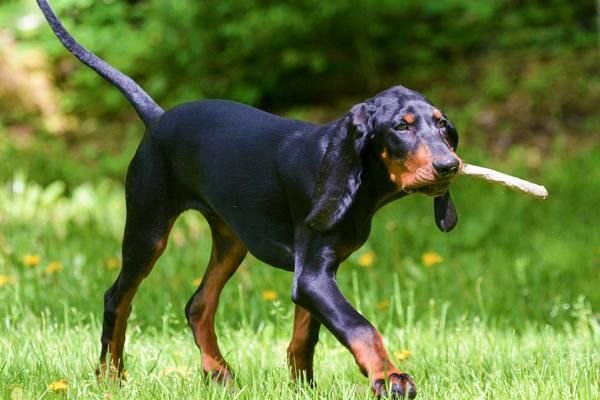
Before diving into specific exercise recommendations, it’s essential to understand the exercise needs of Black and Tan Coonhounds. These dogs have several characteristics that influence their exercise requirements:
1. High Energy Level: Coonhounds are highly energetic dogs, and they need ample exercise to release pent-up energy. Without enough physical activity, they can become restless and may develop behavioral issues.
2. Scent Drive: Black and Tan Coonhounds have an exceptional sense of smell, a trait that’s deeply ingrained due to their hunting background. They love following scents, so they require exercise that engages their nose and mind.
3. Independence: These dogs can be independent and may enjoy exploring on their own. Therefore, it’s crucial to provide opportunities for both on-leash and off-leash exercise in secure areas.
Types of Exercises for Black and Tan Coonhounds
To meet the exercise needs of your Black and Tan Coonhound, consider a variety of activities that cater to their physical and mental well-being:
1. Regular Walks:
- Duration: A minimum of 30 minutes to 1 hour per day.
- Frequency: Daily walks are highly recommended. These walks serve as opportunities for exercise, bonding, and mental stimulation.
2. Playtime:
- Duration: At least 30 minutes of playtime.
- Frequency: Ideally, incorporate play sessions several times a day. Use toys like balls, frisbees, and ropes to engage your Coonhound in active play.
3. Nose Work:
- Duration: 15-30 minutes of scent games.
- Frequency: A couple of times a week. Hide treats or toys for your Coonhound to find, stimulating their keen sense of smell.
4. Hiking and Trail Walks:
- Duration: 1-2 hours or more.
- Frequency: A few times a month or as frequently as your schedule allows. Coonhounds love exploring nature and following scents in the great outdoors.
5. Agility Training:
- Duration: Agility sessions can vary but typically last 20-30 minutes.
- Frequency: Once a week. Agility exercises not only provide physical exercise but also challenge their problem-solving skills.
6. Off-Leash Play:
- Duration: Varies depending on the location.
- Frequency: Whenever possible, let your Coonhound enjoy off-leash play in a secure, enclosed area. This allows them to roam, explore, and follow their noses safely.
7. Swimming:
- Duration: 20-30 minutes of swimming.
- Frequency: As needed or when access to a suitable water source is available. Coonhounds often enjoy water, and swimming provides excellent exercise.
Addressing Breed-Specific Exercise Needs
For Black and Tan Coonhounds, some breed-specific exercise needs should be considered:
1. Scent Work: These dogs excel in scent work, so incorporating activities that engage their sense of smell is essential. Nose work and scent games help satisfy their innate desire to follow scents.
2. Off-Leash Time: Due to their independence, Coonhounds often appreciate off-leash play. Secure areas are a must to ensure their safety while they explore and follow scents.
3. Mental Stimulation: In addition to physical exercise, mental stimulation is vital. Training sessions, puzzle toys, and interactive games can keep their minds sharp and prevent boredom.
4. Consistency: Coonhounds thrive on routine. Consistent daily exercise helps them expend energy and leads to a more balanced and contented pet.
5. Socialization: Coonhounds are generally social dogs and enjoy interacting with other dogs. Regular trips to a dog park or playdates can be beneficial for their physical and mental well-being.
Remember that every dog is unique, and it’s important to tailor their exercise routine to their specific needs and preferences. Keep a watchful eye on your Coonhound to gauge their energy levels and adjust the exercise plan accordingly. Always provide ample water and ensure your dog doesn’t overexert themselves, especially in hot weather.
By following these exercise and activity recommendations, you can help your Black and Tan Coonhound live a happy, healthy, and fulfilled life. Regular exercise not only keeps them physically fit but also strengthens the bond between you and your four-legged friend.
Nutrition and Feeding Guidelines for Black and Tan Coonhounds
Introduction
Proper nutrition is a fundamental aspect of caring for your Black and Tan Coonhound. Their energetic nature and unique characteristics require a balanced diet to keep them healthy and active. In this section, we will discuss nutrition guidelines and feeding recommendations tailored to the specific needs of Black and Tan Coonhounds.

Understanding Your Coonhound’s Nutritional Needs
To determine the right diet for your Black and Tan Coonhound, it’s essential to consider several factors that influence their nutritional requirements:
1. Size: Black and Tan Coonhounds are medium to large dogs, and their size affects their calorie and nutrient needs. Larger dogs typically require more calories.
2. Age: A Coonhound’s nutritional needs change with age. Puppies, adults, and seniors have different requirements. It’s important to select the appropriate food for their life stage.
3. Activity Level: Coonhounds are highly active dogs. The more exercise they get, the more calories they’ll require to fuel their activities.
4. Individual Health: Some Coonhounds may have specific health issues or allergies that necessitate a specialized diet. Consult with your veterinarian if your dog has unique dietary requirements.
Dietary Recommendations for Black and Tan Coonhounds
1. High-Quality Dog Food: Choose a high-quality commercial dog food that meets the nutritional standards set by the Association of American Feed Control Officials (AAFCO). Look for options specifically designed for large breeds or active dogs.
2. Protein: Coonhounds benefit from a diet with high-quality animal protein sources. Look for dog food that lists a quality protein source, such as chicken, turkey, or lamb, as the first ingredient.
3. Fat: Adequate fat content is essential for Coonhounds’ energy needs. Look for dog food with moderate fat levels, ideally around 10-15%.
4. Carbohydrates: Carbohydrates from sources like whole grains, vegetables, and fruits provide essential nutrients and fiber. Avoid foods with excessive filler ingredients like corn or soy.
5. Portion Control: To prevent obesity, portion control is crucial. Divide your Coonhound’s daily food into two or three meals to avoid overeating.
6. Avoid Overfeeding: Coonhounds have hearty appetites, but it’s important to resist overfeeding. Follow the feeding guidelines on the dog food package and consult with your veterinarian for specific recommendations based on your dog’s age, weight, and activity level.
7. Hydration: Ensure that your Coonhound has access to fresh water at all times. They can be active and may require more water than sedentary dogs.
8. Treats and Snacks: Use treats and snacks in moderation. Opt for healthy, dog-friendly options that won’t compromise your Coonhound’s balanced diet.
9. Avoid Table Scraps: Refrain from feeding your Coonhound table scraps, as this can lead to digestive upset and encourage begging behavior.
10. Consult Your Veterinarian: Your veterinarian is your best resource for tailoring a diet to your Coonhound’s specific needs. Regular check-ups will help monitor your dog’s weight and overall health.
Common Dietary Restrictions: While Coonhounds do not have specific dietary restrictions unique to the breed, some dogs may have allergies or sensitivities to certain ingredients. Common food allergens for dogs can include poultry, beef, grains, and dairy products. If your Coonhound displays signs of food allergies or intolerances, such as digestive issues, itching, or skin problems, consult your veterinarian to identify and manage potential dietary restrictions.
Feeding Schedule for Black and Tan Coonhounds
A consistent feeding schedule is essential for your Coonhound’s well-being. Here’s a general feeding schedule guideline:
Puppy (up to 6 months old):
- 3-4 meals a day.
Young Adult (6 months to 2 years):
- 2 meals a day.
Adult (2 years and older):
- 1-2 meals a day.
Keep in mind that these are general guidelines. The number of meals and portion sizes can vary based on your dog’s age, activity level, and individual needs. To determine the right feeding schedule for your Coonhound, consult with your veterinarian.
In conclusion, providing your Black and Tan Coonhound with a balanced and high-quality diet is essential for their health and well-being. By considering their size, age, activity level, and individual needs, you can ensure that your beloved Coonhound receives the nutrition required to maintain their active lifestyle and vibrant health. Always consult with your veterinarian to establish the best diet plan for your specific dog.
Personal Stories and Testimonials
Real-Life Experiences with Black and Tan Coonhounds
To gain a deeper understanding of what it’s like to share your life with a Black and Tan Coonhound, we’ve gathered personal stories and testimonials from owners who have had the pleasure of having these remarkable dogs as part of their families. These stories provide insights into the breed’s characteristics and the joys and challenges of Coonhound ownership.
Story 1: Bella’s Unwavering Loyalty
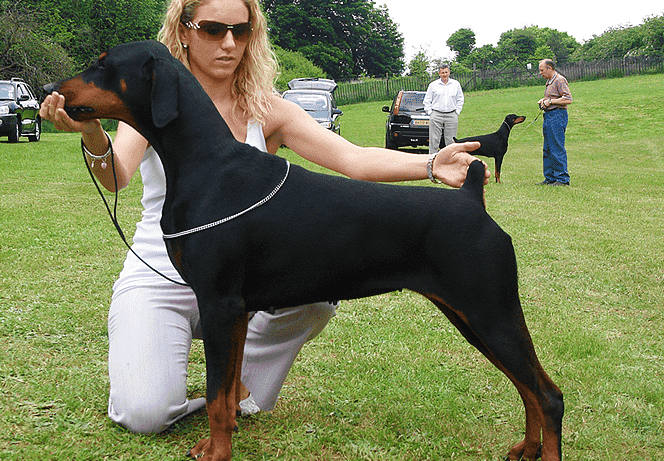
Owner: Sarah W., Georgia
Bella, my Black and Tan Coonhound, has been an absolute blessing to our family. Her loyalty and affection are beyond words. We got Bella when she was just a puppy, and from day one, she’s been the most loving companion. Whether it’s snuggling with us on the couch or patiently watching over our kids as they play in the yard, she’s always there with a wagging tail.
Bella’s energy and enthusiasm for life are infectious. Our daily walks have become a cherished ritual. She’s our constant motivator to get outdoors and stay active. Her scent-tracking skills are out of this world. While we don’t use them for hunting, I’ve hidden treats for her in the yard, and it’s incredible to watch her nose at work.
However, Bella’s strong nose can sometimes get her into trouble. I’ve learned the hard way to make sure our fence is secure. A few times, she’s managed to track an irresistible scent beyond the yard, leaving me in a bit of a panic. But it’s all part of the Coonhound experience.
What stands out most about Bella is her unwavering loyalty. She’s not just a pet; she’s a beloved family member. Her sweet temperament, combined with her protective instincts, gives us peace of mind. I can’t imagine our lives without her. The Black and Tan Coonhound is truly one of a kind.
Story 2: Max and the Coonhound Community
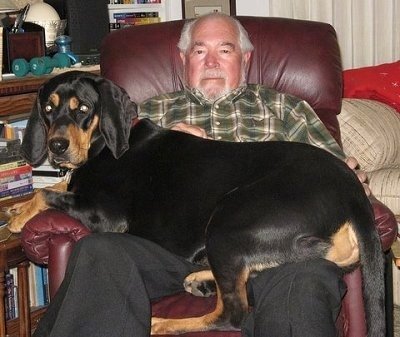
Owner: Mark R., Tennessee
Max, our Black and Tan Coonhound, has introduced us to a welcoming and passionate community of Coonhound enthusiasts. From the moment we brought Max home, we realized he was a special dog. His intelligence, combined with a mischievous streak, made him endlessly entertaining.
One of the first things we noticed about Max was his exceptional scenting ability. We started engaging him in nose work and tracking games, which he absolutely adored. We even joined a local scent dog club where Max could put his skills to the test.
But what’s been truly incredible is the network of Coonhound owners we’ve met along the way. There’s a strong sense of camaraderie among Coonhound enthusiasts. We regularly attend events, hunts, and meetups where our dogs can socialize and do what they love – following their noses. The passion and dedication of this community are inspiring.
While Max does have a strong independent streak, he’s also a very affectionate and loving dog. His expressive eyes convey so much emotion, and he’s a master at convincing us to play just one more game of fetch. We’ve come to appreciate the balance between his independence and his desire to be part of our family.
The adventures and experiences Max has brought into our lives are beyond our wildest expectations. The Black and Tan Coonhound is not just a breed; it’s a lifestyle and a community. Max has enriched our lives in ways we could never have imagined.
Story 3: Adventures with Luna
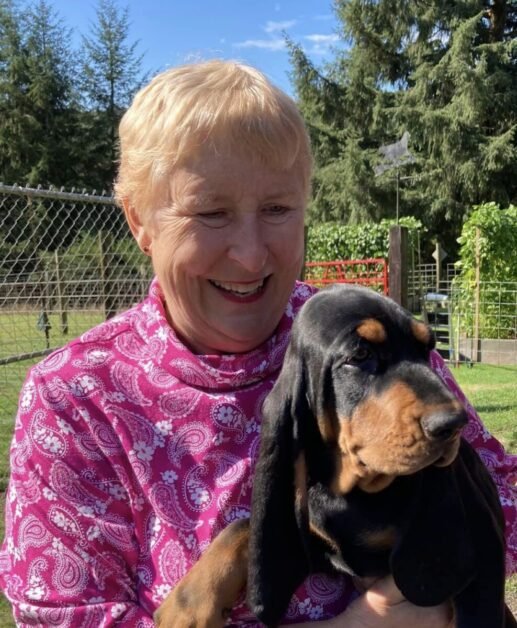
Owner: David and Lisa H., North Carolina
Luna, our Black and Tan Coonhound, has been our adventure companion and a source of endless laughter. We live in the beautiful countryside of North Carolina, and Luna is the perfect fit for our active lifestyle.
One of Luna’s favorite activities is going on hikes and exploring the trails with us. We often take her to the nearby mountains and forests, and she’s in her element. Watching her follow scents and lead us through the wilderness is truly remarkable. Her enthusiasm for the outdoors is infectious, and she’s taught us to appreciate the beauty of nature even more.
Luna’s hunting instincts are strong, and it’s something we’ve embraced. We don’t hunt, but we do engage in various scent games and puzzles to stimulate her mind. Her determination to find hidden treats and solve challenges is impressive. And the famous Coonhound baying? We’ve come to love it; it’s music to our ears.
She’s also brought an abundance of joy into our home. Luna’s goofy antics and playful nature keep us entertained every day. Her sweet and affectionate personality makes her a wonderful companion. She’s also great with our children, and their bond is heartwarming.
However, Luna’s escapades have sometimes led to hilarious mishaps. Her propensity to follow scents has occasionally resulted in her chasing after a squirrel and dragging us along for the ride. But we wouldn’t have it any other way. Luna’s zest for life is infectious, and we’re grateful to have her as a part of our family.
These personal stories illustrate the deep bond and unique experiences that come with Black and Tan Coonhound ownership. Whether it’s their loyalty, scenting abilities, or their loving nature, Coonhounds bring a special kind of magic into the lives of their owners.
The Cost of Owning a Black and Tan Coonhound
Budgeting for Your Four-Legged Friend
Owning a Black and Tan Coonhound is a rewarding experience, but it comes with financial responsibilities. Understanding the costs associated with Coonhound ownership is essential for ensuring your dog’s well-being and a harmonious relationship. In this section, we’ll break down the expenses associated with owning a Black and Tan Coonhound, from upfront costs to ongoing expenditures.
Upfront Costs
1. Adoption or Purchase Price: If you’re adopting a Black and Tan Coonhound from a shelter, the adoption fee typically ranges from $50 to $300. However, if you’re purchasing a puppy from a breeder with a reputable pedigree, the price can be significantly higher, averaging between $800 and $1,500 or more.
2. Spaying/Neutering: Many Coonhounds are spayed or neutered before adoption or purchase. If not, you can expect to pay $200 to $500 for this procedure, depending on your location and the dog’s age.
3. Initial Vaccinations: Your new Coonhound will require vaccinations, including core shots such as rabies and distemper. The cost for initial vaccinations can range from $75 to $100.
4. Microchipping: Microchipping your dog for identification and tracking typically costs around $45 to $75.
5. Essential Supplies: You’ll need to invest in supplies like food and water bowls, a leash, collar, crate, and toys. These initial expenses can total $100 to $200.
6. Licensing and Identification: Many states require dog licensing, which can range from $10 to $30 annually. Additionally, you may want to purchase an identification tag for around $5 to $10.
7. Basic Training Classes: Enrolling your Coonhound in basic obedience classes is highly recommended, and prices can vary, but you might expect to pay $100 to $300 for a multi-week course.
Ongoing Expenses
1. Food: Coonhounds are medium to large dogs, and they have healthy appetites. High-quality dog food can cost around $40 to $70 per month, depending on the brand and your dog’s size.
2. Routine Veterinary Care: Regular vet check-ups, vaccinations, and preventive care for your Coonhound can amount to $300 to $500 annually.
3. Grooming and Hygiene: While Coonhounds have short coats, they still require regular grooming and hygiene maintenance. Budget around $50 to $100 a year for grooming supplies.
4. Toys and Accessories: Coonhounds are playful dogs, and you’ll want to provide them with toys and accessories to keep them mentally and physically engaged. Budget $100 to $200 per year.
5. Training and Socialization: Ongoing training classes or private sessions and socialization activities can cost $100 to $300 annually.
6. Licensing and Identification Renewal: Don’t forget to renew your dog’s license and identification tags, costing around $10 to $30 per year.
7. Parasite Prevention: Regular flea, tick, and heartworm prevention can add another $100 to $200 annually.
8. Emergency Vet Care: It’s wise to budget for unexpected vet visits. While you can’t predict emergencies, having a savings fund or pet insurance can help cover costs during unforeseen situations.
9. Boarding or Pet Sitting: If you travel and can’t take your Coonhound with you, boarding or pet sitting services can range from $20 to $50 per day.
10. Doggy Daycare: Enrolling your Coonhound in doggy daycare for socialization and exercise can cost around $15 to $30 per day.
11. Dental Care: Dental cleanings and care can cost $100 to $300 annually.
12. Food and Water: Your monthly food and water costs will depend on the brand of food you choose and the water consumption of your dog. Allocate an estimated $40 to $70 per month for food and water.
It’s important to remember that these costs can vary based on factors such as your location, the quality of products and services you choose, and your dog’s individual needs. Additionally, unforeseen expenses can arise, so having a financial cushion for unexpected vet bills is a wise precaution.
In conclusion, while owning a Black and Tan Coonhound requires financial commitment, the joy, companionship, and unique experiences they bring into your life are priceless. By budgeting for your Coonhound’s needs, you can ensure they lead a happy and healthy life while enriching your own.
Grooming and Care for Your Black and Tan Coonhound
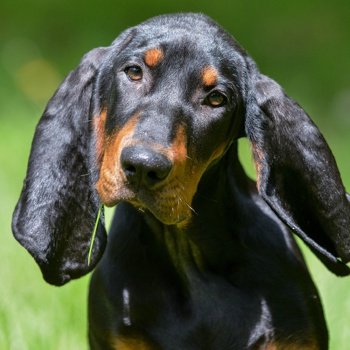
Introduction
Grooming and care are essential aspects of keeping your Black and Tan Coonhound healthy, happy, and comfortable. While Coonhounds have short, sleek coats that are relatively low-maintenance, there are still important grooming routines and care considerations to keep in mind. In this section, we’ll provide you with guidance on grooming practices, health care, and recommendations for specific accessories to ensure your Black and Tan Coonhound receives the best care possible.
Coat Maintenance
Black and Tan Coonhounds have a short, dense coat that’s relatively easy to care for. While they don’t require extensive grooming, there are some key practices to keep their coat in optimal condition:
1. Brushing:
- The short coat of a Coonhound benefits from regular brushing to remove loose hair and distribute natural oils for a healthy shine. A soft bristle brush or grooming mitt is suitable.
- Frequency: Brush your Coonhound once a week to keep their coat in good condition.
2. Bathing:
- Coonhounds are generally clean dogs, and they don’t require frequent baths. Only bathe them when they’re visibly dirty or develop an odor.
- Use a dog-specific shampoo to avoid skin irritation and dryness.
3. Ear Care:
- Due to their long, floppy ears, Coonhounds are more prone to ear infections. Regular ear cleaning is essential.
- Use a vet-approved ear cleaning solution and gently clean their ears to prevent buildup of dirt and moisture.
- Frequency: Check their ears weekly, and clean as needed.
4. Dental Care:
- Maintain good oral hygiene by brushing your Coonhound’s teeth regularly with a dog-specific toothbrush and toothpaste.
- Dental chews or toys can also help reduce tartar buildup.
- Frequency: Aim to brush their teeth every day or at least a few times a week.
5. Nail Trimming:
- Keep your Coonhound’s nails at a healthy length. If you can hear their nails clicking on the floor, it’s time for a trim.
- Use dog nail clippers and be cautious not to cut too close to the quick.
- If you’re uncomfortable doing this yourself, your vet or a professional groomer can handle nail trims.
- Frequency: Nail trimming may be needed every 2-4 weeks, depending on your dog’s activity level.
Health Care
In addition to grooming, regular health care is vital to ensure your Black and Tan Coonhound’s well-being. Here are some important aspects of health care:
1. Vet Check-Ups:
- Schedule routine veterinary check-ups to monitor your Coonhound’s overall health and address any potential issues.
- Keep up with vaccinations, parasite prevention, and recommended health screenings.
- Frequency: At least once a year, but more frequent check-ups may be necessary for puppies, seniors, or dogs with specific health concerns.
2. Parasite Prevention:
- Coonhounds can be susceptible to external parasites like fleas and ticks. Use a vet-approved parasite prevention treatment to keep your dog free from infestations.
- Regularly inspect their coat for any signs of parasites.
3. Spaying/Neutering:
- If your Coonhound is not intended for breeding, consider spaying or neutering. This can prevent unwanted litters and provide health benefits.
- Consult with your vet about the appropriate timing for this procedure.
4. Vaccinations:
- Stay current on your Coonhound’s vaccinations to protect them from various diseases. Core vaccines, including rabies and distemper, are essential.
- Frequency: Follow your vet’s recommended vaccination schedule.
5. Microchipping:
- Consider microchipping your Coonhound for identification and tracking in case they get lost.
- Keep your contact information up to date with the microchip registry.
Specific Accessories and Care Products
Here are some accessories and care products tailored to the Black and Tan Coonhound breed’s needs:
1. Dog Harness: Coonhounds are strong dogs that can pull on a leash. Consider using a dog harness, especially if your dog tends to lead on walks. It provides better control and prevents strain on the neck.
2. Interactive Toys: Coonhounds are intelligent dogs that benefit from mental stimulation. Invest in interactive toys and puzzle feeders to keep their minds engaged and prevent boredom.
3. Tracking Collar: If you’re in an area where Coonhound hunting is common, you may want to consider a tracking collar. These collars allow you to locate your dog using GPS technology, ensuring their safety.
4. Doggie Dental Kit: A doggie dental kit, which includes a toothbrush and toothpaste designed for dogs, makes it easier to maintain your Coonhound’s oral hygiene.
5. Ear Cleaning Solution: Keep a vet-approved ear cleaning solution on hand for regular ear care.
6. Nail Clippers or Grinder: If you’re comfortable trimming your dog’s nails, invest in quality nail clippers or a grinder. Make sure to use them carefully and have styptic powder available in case of accidental cuts.
7. Food and Water Bowls: Choose sturdy, non-tip food and water bowls. Stainless steel or ceramic bowls are good options.
Remember that every dog is unique, and their grooming and care requirements can vary. Pay close attention to your Coonhound’s specific needs and consult with your veterinarian for personalized advice. By providing proper grooming, health care, and using the right accessories, you can ensure that your Black and Tan Coonhound remains happy, healthy, and well-cared for throughout their life.
Choosing and Adopting a Black and Tan Coonhound
Introduction
Adopting a Black and Tan Coonhound is a rewarding experience that offers a loving home to a dog in need and brings a unique companion into your life. In this section, we will explore the reasons for adopting a Black and Tan Coonhound, the research and preparation required for adoption, the adoption process itself, and ethical considerations related to breeding. Whether you’re an experienced dog owner or considering your first canine companion, adopting a Black and Tan Coonhound can be a life-changing decision for both you and your future furry friend.
Reasons for Adoption
Choosing to adopt a Black and Tan Coonhound, or any rescue dog, is a compassionate and fulfilling decision that comes with a multitude of benefits:
1. Giving a Second Chance: By adopting a rescue dog, you are providing a second chance at a loving and safe home for a dog that may have faced challenges in the past. Your kindness can help them overcome past difficulties and thrive in a new environment.
2. Saving a Life: Adopting a Black and Tan Coonhound from a rescue organization or shelter directly saves a dog’s life. Many shelters are overcrowded, and giving a dog a forever home opens up space for more animals in need.
3. Breed-Specific Love: If you’re drawn to the unique qualities and temperament of the Black and Tan Coonhound, adopting one allows you to experience all the wonderful traits this breed has to offer. Each Coonhound has its distinct personality and will bring joy and companionship to your life.
4. Reduced Overpopulation: Supporting rescue and adoption efforts contributes to reducing the overpopulation of dogs. When you adopt, you are promoting responsible pet ownership and discouraging unethical breeding practices.
5. Established Personality: Adult rescue dogs often have well-established personalities, so you’ll have a better understanding of their behavior and temperament before adoption. This can help you find a dog that matches your lifestyle.
Research and Preparation
Before you embark on your journey to adopt a Black and Tan Coonhound, it’s essential to conduct thorough research and prepare for the responsibilities of dog ownership. Here are some steps to guide you in the process:
1. Breed-Specific Needs: Research the Black and Tan Coonhound breed to understand their specific needs and characteristics. Coonhounds are known for their high energy levels, strong scent drive, and independence, so be prepared to accommodate these traits.
2. Financial Responsibility: Calculate the costs associated with dog ownership, including food, grooming, veterinary care, and unexpected expenses. Ensure you have the financial means to provide proper care for your adopted Coonhound.
3. Lifestyle Assessment: Evaluate your daily routine and living situation to determine if it aligns with the breed’s needs. Black and Tan Coonhounds thrive in homes with access to secure outdoor areas for exercise.
4. Training and Socialization: Consider your willingness and ability to invest time in training, socializing, and providing mental stimulation for your Coonhound. These activities are essential to their well-being.
5. Finding a Reputable Rescue: Identify reputable rescue organizations or shelters that specialize in Black and Tan Coonhounds or hound breeds. Research their adoption processes and any requirements.
Adoption Process
The adoption process can vary between different rescue organizations and shelters, but there are some common steps you can expect when adopting a Black and Tan Coonhound:
1. Application: Begin by filling out an adoption application provided by the rescue organization. The application may inquire about your living situation, experience with dogs, and the type of home you can provide.
2. Interview or Home Visit: Some organizations may conduct interviews or home visits to ensure your living environment is suitable for a Coonhound. These visits are meant to verify that your home is safe and secure for your future pet.
3. Adoption Fee: Expect to pay an adoption fee, which usually covers the cost of vaccinations, spaying/neutering, and other initial medical expenses. The fee supports the rescue organization’s mission.
4. Transition Period: Give your adopted Coonhound time to adjust to their new home. Be patient, as they may have some initial anxiety or behavioral challenges as they settle in.
5. Post-Adoption Support: Reputable rescue organizations often provide post-adoption support. Don’t hesitate to reach out if you have questions or need guidance during the transition.
6. Responsible Ownership: Remember that adopting a Black and Tan Coonhound is a lifelong commitment. Ensure you can provide proper care and attention throughout their life.
Breeding and Ethical Considerations
While adopting a Black and Tan Coonhound is a wonderful choice, it’s also essential to understand the ethical considerations related to breeding. Responsible breeding practices are crucial to maintaining the health and genetic diversity of the breed. Here are some insights into these considerations:
1. Responsible Breeding: Responsible breeders prioritize the health, well-being, and genetic diversity of the breed. They conduct health screenings on breeding dogs and ensure that the puppies are raised in a loving and safe environment.
2. Health Screening: Ethical breeders perform health screenings to detect and prevent hereditary conditions and diseases common in the breed. These tests help maintain the overall health of the Black and Tan Coonhound.
3. Genetic Diversity: A diverse genetic pool is essential for the long-term health and vitality of the breed. Ethical breeders work to preserve the breed’s genetic diversity, which helps prevent inherited health problems.
4. Avoiding Puppy Mills: Avoid purchasing puppies from puppy mills, which often prioritize profit over the well-being of the dogs. These establishments typically engage in unethical breeding practices that can result in health and behavioral issues.
5. Rescue Organizations: If you choose to adopt, consider supporting rescue organizations or shelters dedicated to Black and Tan Coonhounds. By doing so, you help provide loving homes to dogs in need and promote ethical treatment of the breed.
By understanding these considerations and choosing to adopt or support ethical breeding practices, you contribute to the betterment of the Black and Tan Coonhound breed. Your decision has a positive impact on their health, well-being, and the overall community of dog lovers.
Conclusion
Adopting a Black and Tan Coonhound is a compassionate choice that offers a loving home to a rescue dog and brings a devoted and unique companion into your life. The adoption process involves thorough research, preparation, and the commitment to providing a loving and secure environment for your future pet. By choosing to adopt and support ethical breeding practices, you positively contribute to the well-being of the Black and Tan Coonhound breed and the broader community of dog lovers. Your decision to open your heart and home to a rescue dog is a truly rewarding one that benefits both you and your new four-legged friend.
Certainly! Here’s a list of 10 common questions and answers about the Black and Tan Coonhound breed, covering unique topics not previously discussed:
1. Are Black and Tan Coonhounds good family dogs?
Yes, Black and Tan Coonhounds can make excellent family dogs. They are known for their affectionate nature and patience with children.
2. Do Black and Tan Coonhounds get along with other pets?
While they have a strong prey drive, many Black and Tan Coonhounds can coexist with other pets, including dogs and cats. Early socialization is key to their success with other animals.
3. How do you train a Coonhound to control their baying or vocalization?
Training Coonhounds to control their baying can be challenging, but it’s possible with consistent, positive reinforcement training. Teaching a “quiet” command and rewarding them when they stop baying is a good approach.
4. Are Black and Tan Coonhounds prone to separation anxiety?
Some Coonhounds can experience separation anxiety, particularly if left alone for long periods. Proper training, socialization, and gradually increasing the time they spend alone can help mitigate this.
5. Do Coonhounds adapt well to apartment living?
Coonhounds are best suited for homes with access to a secure, fenced yard due to their high energy levels. Apartment living can work if you provide them with ample exercise and mental stimulation.
6. What makes the Black and Tan Coonhound a unique hunting dog compared to other breeds?
The Coonhound’s extraordinary scenting abilities, baying vocalization, and versatility as a hunting dog make them unique. They are well-known for tracking raccoons and other games.
7. How often should a Coonhound be groomed?
Coonhounds have short, dense coats that require minimal grooming. Regular brushing to remove loose hair and occasional baths are usually sufficient.
8. Are there any specific health concerns associated with Coonhounds not mentioned in the main sections?
While not uncommon, Coonhounds can be prone to ear infections due to their long, floppy ears. Regular ear cleaning and inspection are essential to prevent infections.
9. Can Black and Tan Coonhounds be used for search and rescue operations?
Yes, their strong sense of smell and tracking abilities make them suitable for search and rescue work. Some Coonhounds are trained for these purposes.
10. What is the origin of the name “Coonhound”?
– The name “Coonhound” reflects their primary role as raccoon hunters. Their distinctive black and tan coat pattern was well-suited for tracking raccoons at night, and the name simply describes their hunting specialization.

















